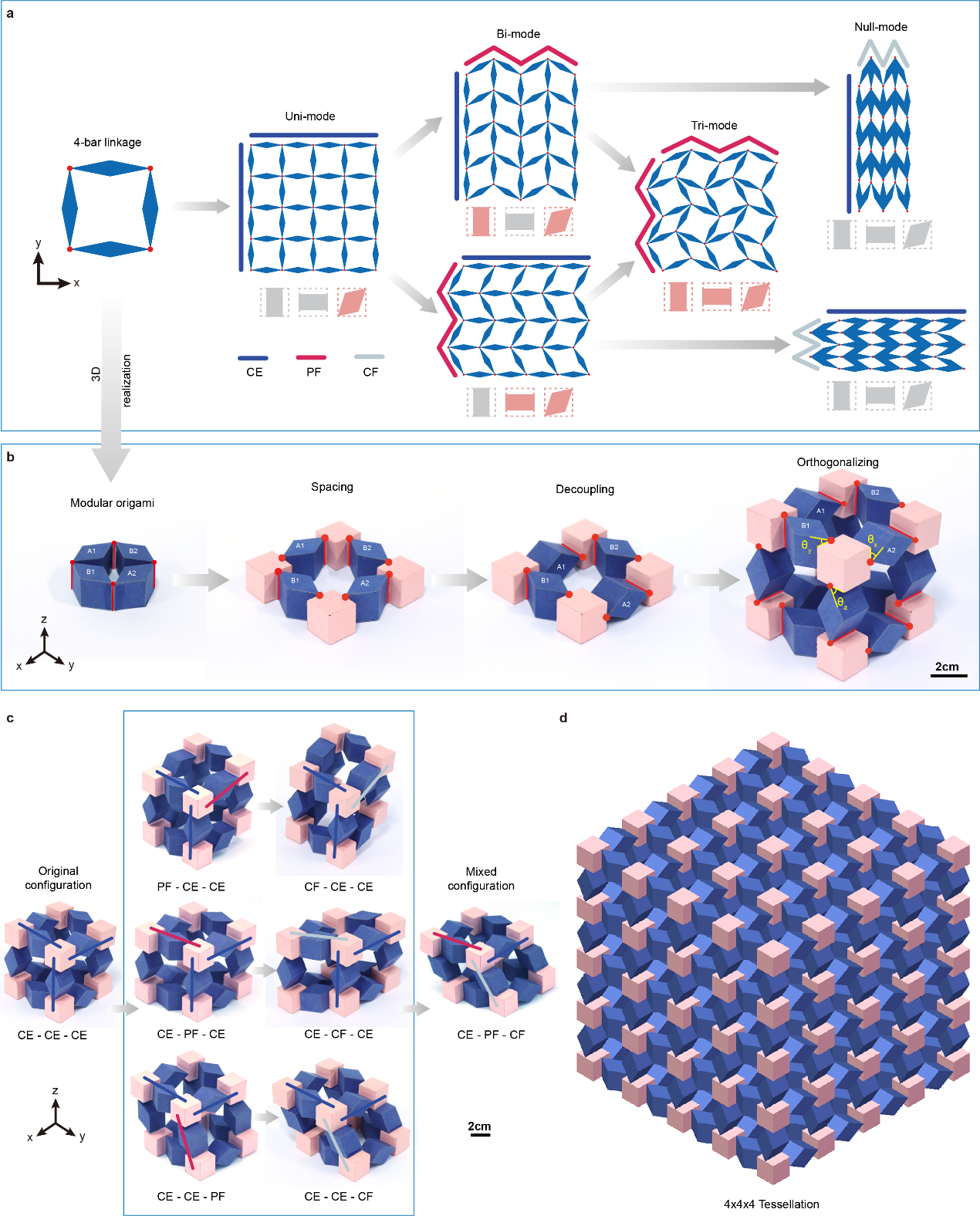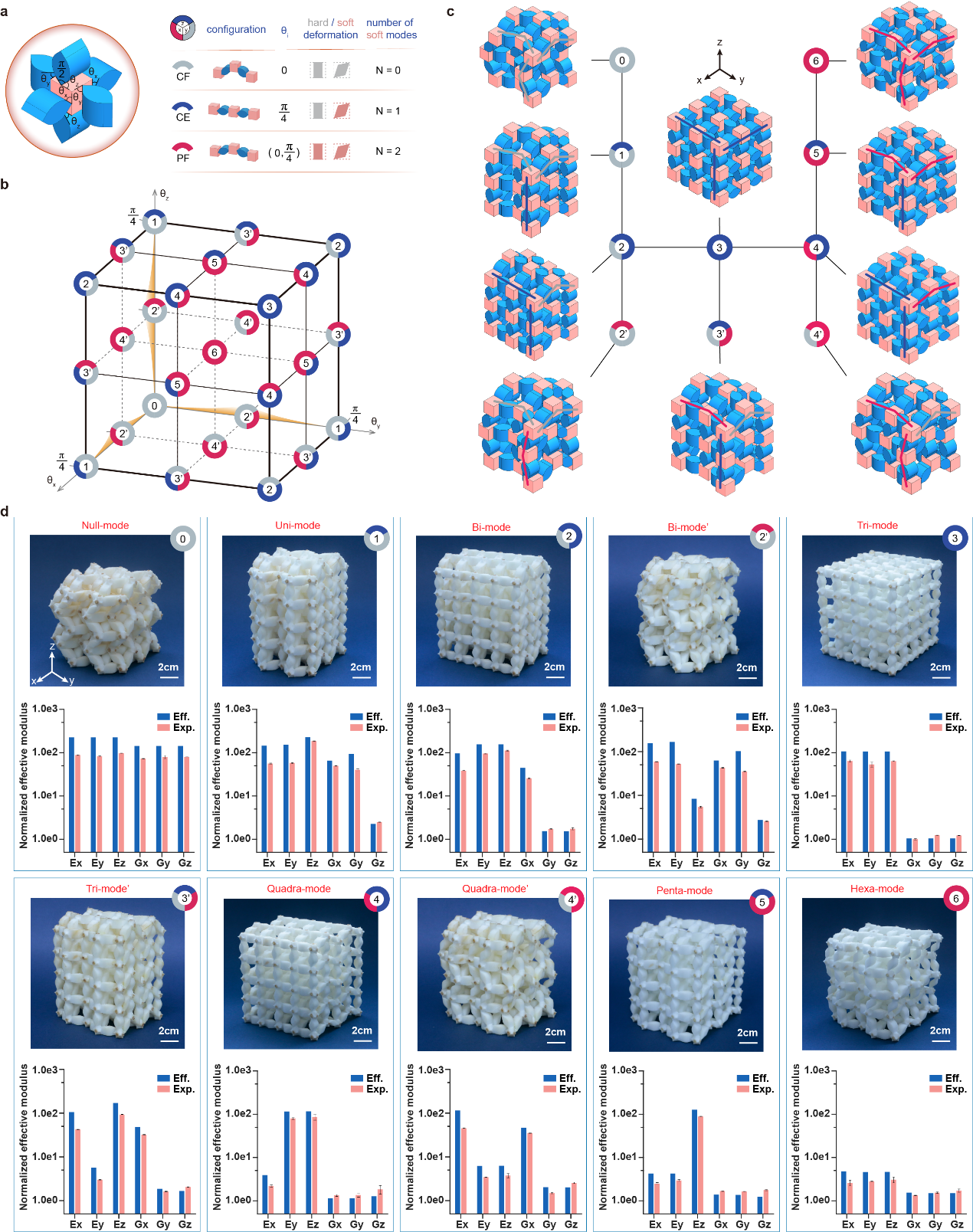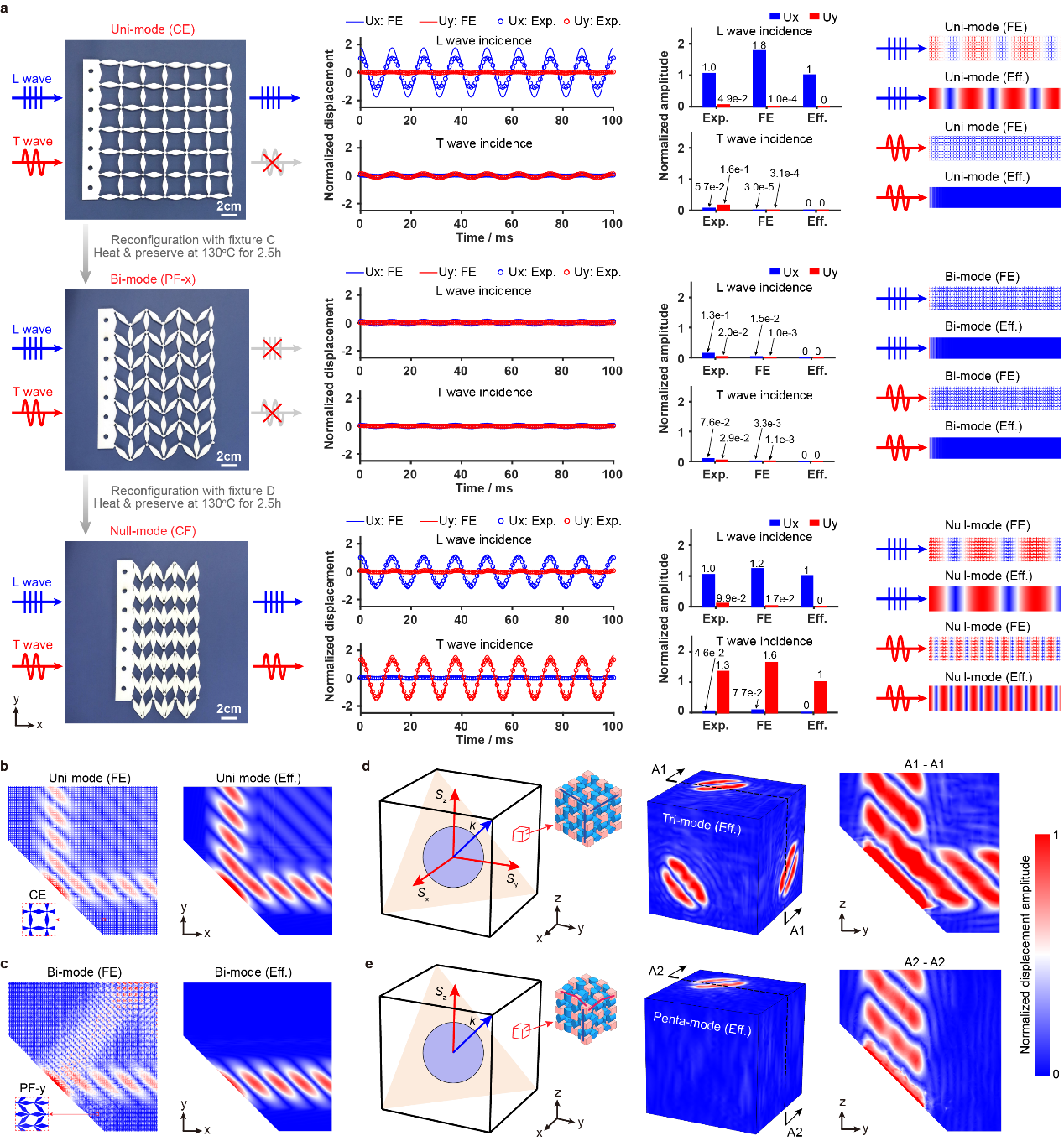Research
Team
Publications
News
|
New Publication: Engineering Zero Modes in Transformable Mechanical Metamaterials
From: Date: 2023-03-08 Mechanical metamaterials have counterintuitive properties that are unavailable among the conventional materials, e.g., negative Poisson’s ratio, graded stiffness, non-reciprocal response, etc. Modular origami structures provide a powerful platform for designing 3D flexible metamaterials with transformability and deformation modes that cost little to no elastic energy, called zero modes. The number of zero modes could bring extremal static as well as dynamic properties. One of the most spectacular and direct applications of zero modes is in the design of acoustic “invisibility” cloaks by identifying penta-mode materials. However, due to the lack of a blueprint for the systematic designs of the corresponding zero modes, little to no work has succeeded in realizing those materials with specific number of zero modes or capability to be transformed among all seven different zero modes, which are, null-mode (solid state), uni-mode, bi-mode, tri-mode, quadra-mode, penta-mode and hexa-mode (near-gaseous state). Recently, the team of Professor Yan Chen from the school of mechanical engineering of Tianjin University, in cooperation with the team of Professor Rui Zhu of the school of aerospace engineering of Beijing Institute of Technology, proposed a transformable mechanical metamaterial based on modular origami, realizing all seven different zero modes and the reversible transformation among configurations. Tunable wave manipulations are further investigated in 1D-, 2D and 3D-systems. The results were published online in Nature Communications on March 7, 2023. The co-corresponding authors of the paper are Professor Yan Chen of Tianjin University and Professor Rui Zhu of Beijing Institute of Technology. The co-first authors are Hu Zhou, a Ph.D. student of Beijing Institute of Technology, and Zhibo Wei, a Ph.D. student of Tianjin University. The researchers start with planer 4-bar linkage tessellated structure. The homogenization analyzation shows that the metamaterial behaviors like a null-mode, a uni-mode, a bi-mode or a tri-mode extremal material when the 2D tessellation is reconfigured in the CF (completely folded), CE (completely extended), PF (partially folded)-in-one-direction and PF-in-two-direction configurations, respectively. Then, the researchers develop a 3D zero-mode metamaterial which can freely transform elasticity tensors among all seven types of 3D extremal materials covering the solid null-mode to the gas-like hexa-mode via the realization of the decoupled 4-bar linkage motions in the three orthogonal planes in the 3D system. Fig. 1 Design concept and 3D tessellation for transformable mechanical metamaterial. All seven types of extremal metamaterials ranging from null-mode (solid state) to hexa-mode (near-gaseous state) are reported to be reversibly transformed from one state to another, which is verified by the 3D-printed Thermoplastic Polyurethanes prototypes and static experiments. Taking tri-mode and penta-mode configuration for example, it can be found that the compressive moduli in all three orthogonal directions of the tri-mode are approximately two orders of magnitude larger than the shear moduli, verifying the existence of the three pure shear zero modes which are predicted with homogenization method. After transforming into the penta-mode, only the z-directional compressive modulus keeps (two orders of magnitude larger than any other compressive or shear moduli), which agrees well with the property of penta-mode. The TPU sample can transform reversibly into a target configuration by following a heat treatment process with a specific fixture. Fig. 2 The reconfiguration and experimental validation of a 3D transformable metamaterial. Next, the researchers investigate this proposed metamaterial for its completed transformability covering null-mode (solid state) to hexa-mode (near-gaseous state). Ten distinctive extremal metamaterials are demonstrated along with zero-mode numbers and the corresponding origami tessellations. They also perform experimental validations on the ten extremal metamaterials with a 3D printed 4x4x4 tessellation which can be transformed among all ten extremal metamaterials. Fig. 3 Schematic diagram of the 3D mechanical metamaterial’s transformability from null-mode to hexa-mode and its experimental validation. The customizable elasticity tensor of the transformable metamaterial can also lead to unconventional dynamic properties. The one dimensional (1D) polarized elastic wave manipulation with the fabricated transformable metamaterial sample is experimentally illustrated. More interestingly, when 2D and 3D wave propagations are considered, wave-function programmability can be achieved not only on the wave polarization but also on the wave direction. By leveraging the dimension as well as the scale of the metamaterial system, one can realize more complicated programmable functionalities where different combinations of wave-direction and wave-polarization controls can be utilized. Fig. 4 Dynamic experiments and wave-function programmability of the transformable metamaterial. In summary, the researchers have designed a 3D transformable mechanical metamaterial to engineer extremal elasticity tensors ranging from solid to nearly gaseous state. Static and dynamic experiments are conducted to validate the transformable elasticity as well as the reprogrammable polarized wave control ability. The reported design methodology also provides a versatile tool to engineer flexible metamaterials in various scales (if fabrication allows) and domains (such as mechanics, acoustics and photonics).
Hu Z#, Wei Z#, Wang K, Chen Y*, Zhu R*, Huang G, Hu G. Engineering zero modes in transformable mechanical metamaterials. Nature Communications, 2023, 14(1): 1266. |




